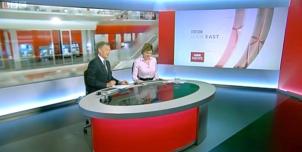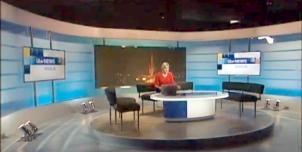Full Freeview on the Sudbury (Suffolk, England) transmitter
| Google Streetview | Google map | Bing map | Google Earth | 52.005,0.786 or 52°0'17"N 0°47'8"E | CO10 5NG |
The symbol shows the location of the Sudbury (Suffolk, England) transmitter which serves 440,000 homes. The bright green areas shown where the signal from this transmitter is strong, dark green areas are poorer signals. Those parts shown in yellow may have interference on the same frequency from other masts.
This transmitter has no current reported problems
The BBC and Digital UK report there are no faults or engineering work on the Sudbury (Suffolk, England) transmitter._______
Digital television services are broadcast on a multiplexes (or Mux) where many stations occupy a single broadcast frequency, as shown below.
64QAM 8K 3/4 27.1Mb/s DVB-T MPEG2
H/V: aerial position (horizontal or vertical)
The Sudbury (Suffolk, England) mast is a public service broadcasting (PSB) transmitter, it does not provide these commercial (COM) channels: .
If you want to watch these channels, your aerial must point to one of the 80 Full service Freeview transmitters. For more information see the will there ever be more services on the Freeview Light transmitters? page.
Which Freeview channels does the Sudbury transmitter broadcast?
If you have any kind of Freeview fault, follow this Freeview reset procedure first.Digital television services are broadcast on a multiplexes (or Mux) where many stations occupy a single broadcast frequency, as shown below.
64QAM 8K 3/4 27.1Mb/s DVB-T MPEG2
H/V: aerial position (horizontal or vertical)
The Sudbury (Suffolk, England) mast is a public service broadcasting (PSB) transmitter, it does not provide these commercial (COM) channels: .
If you want to watch these channels, your aerial must point to one of the 80 Full service Freeview transmitters. For more information see the will there ever be more services on the Freeview Light transmitters? page.
Which BBC and ITV regional news can I watch from the Sudbury transmitter?

BBC Look East (East) 0.8m homes 3.2%
from Norwich NR2 1BH, 77km north-northeast (24°)
to BBC East region - 27 masts.
70% of BBC East (East) and BBC East (West) is shared output

ITV Anglia News 0.8m homes 3.2%
from NORWICH NR1 3JG, 78km north-northeast (24°)
to ITV Anglia (East) region - 26 masts.
All of lunch, weekend and 80% evening news is shared with Anglia (West)
Are there any self-help relays?
| Felixstowe West | Transposer | 1000 homes +1000 or more homes due to expansion of affected area? | |
| Witham | Transposer | 14 km NE Chelmsford. | 118 homes |
How will the Sudbury (Suffolk, England) transmission frequencies change over time?
| 1984-97 | 1997-98 | 1998-2011 | 2011-13 | 1 Aug 2018 | |||||
| B E T | B E T | B E T | E T | K T | |||||
| C29 | SDN | ||||||||
| C31 | ArqA | ||||||||
| C35 | C5waves | C5waves | |||||||
| C37 | ArqB | ||||||||
| C41 | ITVwaves | ITVwaves | ITVwaves | D3+4 | D3+4 | ||||
| C44 | BBC2waves | BBC2waves | BBC2waves | BBCA | BBCA | ||||
| C47 | C4waves | C4waves | C4waves | BBCB | BBCB | ||||
| C51tv_off | BBC1waves | BBC1waves | BBC1waves | ||||||
| C56tv_off | ArqB | ||||||||
| C58tv_off | SDN | ||||||||
| C60tv_off | -ArqA |
tv_off Being removed from Freeview (for 5G use) after November 2020 / June 2022 - more
Table shows multiplexes names see this article;
green background for transmission frequencies
Notes: + and - denote 166kHz offset; aerial group are shown as A B C/D E K W T
waves denotes analogue; digital switchover was 6 Jul 11 and 20 Jul 11.
How do the old analogue and currrent digital signal levels compare?
| Analogue 1-4 | 250kW | |
| SDN, ARQA, ARQB, BBCA, D3+4, BBCB | (-4dB) 100kW | |
| Analogue 5 | (-7dB) 50kW | |
| Mux 2* | (-14.9dB) 8.1kW | |
| Mux B* | (-15.2dB) 7.5kW | |
| Mux 1* | (-15.5dB) 7kW | |
| Mux A* | (-17dB) 5kW | |
| Mux C* | (-22.2dB) 1.5kW | |
| Mux D* | (-23.6dB) 1.1kW |
Which companies have run the Channel 3 services in the Sudbury transmitter area
|
|
Tuesday, 3 October 2023
S
Steve Donaldson12:39 AM
nick : Aldeburgh is currently broadcasting 3 multiplexes at 10kW each. The former analogue consisted of four 10kW channels. Assuming the antenna hasn't been changed (the mb21 Transmitter Gallery doesn't say it has) then perhaps it may need changing in order to take the COM multiplexes, even if they were to operate at half the PSB power.
There is no need to worry that the Aldeburgh transmitter may buck the trend by changing from Group A to Group B in order to become SFN with Sudbury. "If" it were to broadcast the COMs they will be on channels 26, 30 and 32, as these are the channels that have been co-ordinated by international neighbours for that station.
| link to this comment |
C
Chris.SE1:51 AM
nick :
If you wanted to go SFN, the antenna and transmitters would have to be changed (it probably can't with Sudbury as I think it might be too far away. Also it's a relay of Tacolneston which is closer). That's not a cost the commercial operators were/are prepared to pay for the small number of households it would cover (if they were prepared it would have happened). If the option Steve suggested was chosen, it's obviously a cost they still weren't prepared to pay for the small number of households!
| link to this comment |
Wednesday, 11 October 2023
N
nick 12:09 AM
Chris and Steve.
Many thanks, a further incentive to go to freesat. However, I think this is yet another example of an uncaring government which does nothing to protect consumers in so many areas. Freeview light customers are being discriminated against.
I have done further tinkering with aerials. Channel 37 remains the hardest to receive during these tropo conditions, due to appalling signal quality as opposed to strength. but when those conditions go, it almost delivers the strength and quality of the rest. I have made a very high gain aerial, [very long] which works better than other high gain aerials simply because it is more directional and is better at rejecting whatever is affecting 37.
| link to this comment |
S
Steve Donaldson12:22 AM
nick : This page on A.T.V. is on combating co-channel interference. A high gain antenna and attenuator is one approach, where the objective is to increase the ratio of the wanted signal to the unwanted one:
How to combat co-channel interference A.T.V. Poles, Brackets, Clamps & Aerials
| link to this comment |
Sunday, 15 October 2023
N
nick 10:54 PM
Steve,
thanks, fascinating, and I see the French have some powerful xmitters
I would still think the interference if that is what it is is more likely to come from Holland, but if there is no xmitter on 37, it can't be. On analogue we often had interference from there. With digital we just get 'no signal' so have no idea of the culprit.
How about Belgium?
I really do not want to attenuate a signal. I need the benefits of a high gain aerial.
Now that the tropo has finished, 37 has settled down.
| link to this comment |
Friday, 27 October 2023
N
nick 2:07 PM
can anyone tell me what a plus channel is? Felixtowe uses one.
| link to this comment |
S
StevensOnln13:14 PM
nick : If you're referring to UHF channels, it means that the multiplex is slightly offset from the centre of the channel. Most TVs and boxes should still tune it without any problems either via automatic or manual tuning.
| link to this comment |
S
Steve Donaldson5:08 PM
nick : As per my comment on the Felixstowe page, I believe the positive offset on C33 (PSB1) is a mistake. The Freeview Detailed Coverage Checker does not show any offset on any of the three channels of Felixstowe.
Additionally, the 700MHz Clearance spreadsheet from Ofcom and the 700MHz Clearance Events sheet for the Anglia region published by Digital UK does not show offset.
| link to this comment |
N
nick 7:03 PM
to the two Steves,
Thanks.
Whether Felixtowe uses one or not, I am interested to know what it means. Can they have some stations using 33 and some using 33+? If not, what is the point of it?
| link to this comment |
S
Steve Donaldson8:54 PM
nick : No. A multiplex is either minus offset, centre-channel or plus offset. Most transmitters are centre-channel, meaning no offset.
See the entry "Offset" under Glossary here:
Digital television transmitter details - Ofcom
This is what it says (I have added the double quotes because I think it makes it clearer):
---
Offset: A "+" or "-" indicates that the frequency is offset by +0.167MHz or -0.167MHz with respect to the channel centre.
---
Take C33 as an example. The centre of the channel is 570.000MHz. The bandwidth of a DVB broadcast is 8MHz. Therefore:
- a signal which is centre channel (has no offset) spans from 566.000MHz to 574.000MHz;
- a signal which is negative offset spans from 565.833MHz to 573.833MHz, and;
- a signal which is positive offset spans from 566.167MHz to 574.167MHz.
| link to this comment |
Select more comments
Your comment please!




